Mayagüez, Puerto Rico
Mayagüez (Spanish pronunciation: [maʝaˈɣwes]) is the eighth-largest[2] municipality of Puerto Rico. It was founded as Nuestra Señora de la Candelaria, and is also known as La Sultana del Oeste (The Sultaness of the West), Ciudad de las Aguas Puras (City of Pure Waters), or Ciudad del Mangó (City of the Mango). On April 6, 1894, the Spanish Crown gave it the formal title of Excelente Ciudad de Mayagüez (Excellent City of Mayagüez).[3][4] Mayagüez is located in the center of the western coast on the island of Puerto Rico. It is a principal city of the Mayagüez Metropolitan Statistical Area and the Mayagüez–San Germán–Cabo Rojo Combined Statistical Area.
Mayagüez Municipio de Mayagüez | |
|---|---|
City and Municipality | |
 Statue in Plaza Colón | |
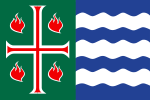 Flag Coat of arms | |
| Nicknames: "La Sultana del Oeste", "La Ciudad de las Aguas Puras", "El Pueblo del Mangó" | |
| Anthem: "Mi patria es un oasis" | |
 Map of Puerto Rico highlighting Mayagüez Municipality | |
| Coordinates: 18°12′04″N 67°08′23″W | |
| Commonwealth | |
| Founded | September 18, 1760 |
| Founded by | Faustino Martínez de Matos Juan de Silva Juan de Aponte |
| Wards | |
| Government | |
| • Mayor | José Guillermo Rodríguez (PPD) |
| • Senatorial dist. | Mayagüez |
| • Representative dist. | 18 and 19 |
| Area | |
| • City and Municipality | 274.09 sq mi (709.89 km2) |
| • Land | 77.63 sq mi (201.07 km2) |
| • Water | 196.46 sq mi (508.82 km2) |
| Highest elevation | 1,577 ft (480.6 m) |
| Lowest elevation | 0 ft (0 m) |
| Population (2010) | |
| • City and Municipality | 89,080 |
| • Density | 330/sq mi (130/km2) |
| • Metro | 115,048 |
| • CSA | 251,260 |
| Demonym(s) | Mayagüezanos |
| Time zone | UTC−4 (AST) |
| ZIP Codes | 00680, 00681, 00682 |
| Area code(s) | 787/939 |
| Major routes | |
| GNIS feature ID | 1611495[1] |
| Website | www |
History
The Mayagüez Metro Area (and part of Añasco) lies today on two former Taíno Cacicazgos (chiefdoms): Yaguex and Yagüeca, a region noted for its record of colonial resistance (i.e., Urayoán and Legend of Diego Salcedo). The Tainos constituted the majority of the island's inhabitants at the time of contact with Europeans in 1493 and called it Borikén or Borinquen, which means: "the great land of the valiant and noble Lord" or "land of the great lords." Today, this appellation and its variations continue to designate the Island of Puerto Rico and its people. These Taínos came from South American branches of Arawakan speakers, more specifically from Venezuela, and lived in small villages, organized their society in clans and named their chiefs Cacique. They were farmers who domesticated crops as pineapples, cassava, and sweet potatoes supplemented by fish and seafood.
Mayagüez was founded on September 18, 1760 by a group led by brothers Faustino and Lorenzo Martínez de Matos, Juan de Silva and Juan de Aponte, at a hill located about one kilometer inland from Mayagüez Bay and the outlet of the Yagüez River. The Spanish Crown granted the founders the right to self-government in 1763, formally separating the town from the larger Partido de San Germán. The settlement was named Nuestra Señora de la Candelaria de Mayagüez (Our Lady of Candelaria of Mayagüez) to evoke an apparition of the Virgin Mary on the island of Tenerife, one of the Canary Islands. Most of the town's settlers, including its founders, migrated from the archipelago, whose patron saint is the Virgin of Candelaria.

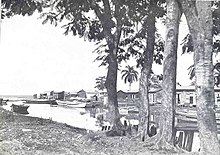
On May 7, 1836, the settlement was elevated to the royal status of villa, and Rafael Mangual was named its first mayor. At the time, the villa's principal economic activity was agriculture. The famous patriot, educator, sociologist, philosopher, essayist, and novelist Eugenio María de Hostos was born in Mayagüez in 1839.
On July 10, 1877 the villa received its city charter from the Royal Crown of Spain.
The United States took control of Puerto Rico from Spain in the aftermath of the Spanish-American War under the terms of the Treaty of Paris of 1898. In 1899, the United States conducted its first census of Puerto Rico finding that the population of Mayagüez was 35,700.[5]
The city's main Roman Catholic church, Our Lady of the Candelaria, was built in a plot consecrated on August 21, 1760. Its first masonry building was erected in 1780. The current church was built in 1836, and was rebuilt in 1922. The redesign by architect Luis Perocier sought to restore the building to its original splendor. The 1918 San Fermín earthquake had destroyed the temple's ceiling, and a lightning bolt struck and tore down a wedge-shaped corner of one of its two bell towers. However, lack of proper funding and the extent of the damage of the original structure forced the rebuilding to be scaled-down considerably.[6]
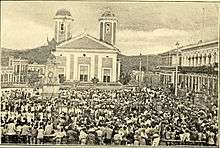
In 1911, the College of Agriculture and Mechanic Arts was founded in Mayagüez. Today it is known as the University of Puerto Rico at Mayagüez (UPRM)—the Caribbean's leading engineering institution.
Between 1962 and 1998 Mayagüez was a major tuna canning and processing center. At one time, 80% of all tuna products consumed in the United States were packed in Mayagüez (the biggest employer, StarKist, had 11,000 employees working three daily shifts in the local plant's heyday). Mayagüez was also a major textile industry hub; almost a quarter of all drill uniforms used by the United States Army were sewn in the city. Today, Mayagüez is the fifth-largest city and is considered one of the most important cities in the island. The city is centered on the impressive Spanish-style Plaza Colón, a tribute to Christopher Columbus, whose stature stands in the middle of the square, surrounded by 16 bronze statues.
Mayagüez has become a major college town with the establishment of the UPRM, the now closed Eugenio María de Hostos Law School and the Pontifical Catholic University of Puerto Rico.
Hurricane Maria on September 20, 2017 triggered numerous landslides in Mayagüez. In some areas of Mayagüez, there were over 25 landslides per square mile due to the significant amount of rainfall.[7][8]
Geography
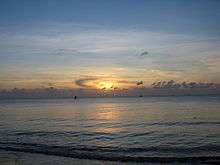
Mayagüez is located near the geographical center of the west coast of Puerto Rico about two to three hours by automobile from San Juan. Its land area is 77.6 square miles (201.06 km2).[9] The city's terrain includes; coast plains, river valleys, marshland, hills and mountains. Of its multiple rivers and streams, the two most important are the Río Yagüez, which flows from the Central Mountain Range through downtown until it empties into the Mona Passage; and the Río Guanajibo, which flows through several neighborhoods in the southern portion of the municipality until it empties in the Mona Passage.[10]
Climate
Mayagüez has a tropical monsoon climate (Köppen climate classification Am). The city has the most extreme weather of the island. The high frequency of severe storms in the summer can produce strong winds, floods, waterspouts, and sometimes hail and even tornadoes. The average annual temperature is 75 °F (24 °C). Winter is usually quite dry and cool, with temperatures between 82 °F (28 °C) and 55 °F (13 °C). Summer is usually very hot and humid, with temperatures reaching 95 °F (35 °C), with heat index of up to 115 °F. From May to October, most evenings experience severe thunderstorms, due to heat, humidity and the topography of the area.
| Climate data for Mayagüez, Puerto Rico | |||||||||||||
|---|---|---|---|---|---|---|---|---|---|---|---|---|---|
| Month | Jan | Feb | Mar | Apr | May | Jun | Jul | Aug | Sep | Oct | Nov | Dec | Year |
| Record high °F (°C) | 95 (35) |
96 (36) |
97 (36) |
98 (37) |
98 (37) |
98 (37) |
99 (37) |
99 (37) |
101 (38) |
100 (38) |
98 (37) |
97 (36) |
101 (38) |
| Average high °F (°C) | 84 (29) |
86 (30) |
87 (31) |
88 (31) |
89 (32) |
91 (33) |
91 (33) |
92 (33) |
91 (33) |
90 (32) |
89 (32) |
86 (30) |
89 (32) |
| Average low °F (°C) | 64 (18) |
64 (18) |
66 (19) |
68 (20) |
70 (21) |
73 (23) |
75 (24) |
76 (24) |
76 (24) |
73 (23) |
70 (21) |
67 (19) |
70 (21) |
| Record low °F (°C) | 51 (11) |
42 (6) |
50 (10) |
57 (14) |
57 (14) |
60 (16) |
65 (18) |
67 (19) |
60 (16) |
62 (17) |
47 (8) |
48 (9) |
42 (6) |
| Average precipitation inches (mm) | 0.7 (17) |
2.0 (52) |
1.5 (39) |
4.8 (123) |
10.7 (271) |
5.2 (131) |
6.6 (168) |
11.8 (299) |
12.6 (321) |
7.4 (189) |
7.8 (198) |
4.8 (123) |
67.4 (1,713) |
| Source: The Weather Channel[11] | |||||||||||||
Cityscape
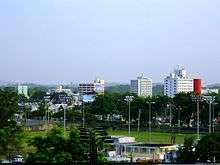
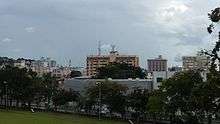
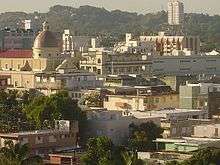
Barrios
The municipio has an estimated population of just over 100,000 spread over 21 wards (barrios) including Mayagüez Pueblo (The downtown area and the administrative center of the city). One of the wards is Isla de Mona e Islote Monito, which consists of the offshore islands of Mona Island and Monito Island. This is the largest ward by land area and at the same time the only one without any permanent population. Also, uninhabited Desecheo Island belongs to the municipality as part of Sabanetas barrio.[12][13][14][15]
Mayagüez Pueblo is further subdivided into these wards:
- Candelaria
- Cárcel
- Marina Septentrional
- Marina Meridional
- Río
- Salud[16]
Sectors
Barrios (which are like minor civil divisions)[17] in turn are further subdivided into smaller local populated place areas/units called sectores (sectors in English). The types of sectores may vary, from normally sector to urbanización to reparto to barriada to residencial, among others.[18][19][20]
The sectors that comprises Mayagüez City are:
- Balboa
- Barcelona
- El Seco
- El Liceo
- El Pueblo
- La Mineral
- La Quinta
- París
- Trastalleres
Other notable neighborhoods or sectors:
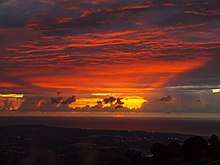
- El Maní—community in Sabanetas
- Mayagüez Terrace—development in Algarrobo, near the UPRM Campus
- Alturas de Mayagüez—development in Algarrobo, near the Holiday Inn Hotel and the Regional Distribution Center
- El Cerro de las Mesas—known for being the home of "CROEM" and for its picture perfect views of the City from Camino Berrios.
- Buena Vista—a hilltop picturesque community next to the downtown area.
- Colombia—a famous former slum, alongside a Government Center.
- Columbus Landing—the second oldest public housing project (caserio) in Puerto Rico.
- Dulces Labios—a picturesque community alongside PR-2 famous for its history and its musical activities.
- Ensanche Martínez (La Bosque)—student area, near the UPRM Campus.
- Ensanche Ramírez—a hilltop high class development, near the UPRM Campus.
- Ensanche Vivaldi—student area, near the UPRM Campus.
- La Riviera—student area.
- Ponce de León—development in Mayagüez Arriba next to Luis Muñoz Rivera Park (eastern outskirts).
- Santurce—community next to the Old Municipal Cemetery.
- Vadi-Cristy—community alongside PR-2 and the downtown area.
Special Communities
Of the 742 places on the list of Comunidades Especiales de Puerto Rico, the following barrios, communities, sectors, or neighborhoods were in Mayagüez: Balboa, Barrio Salud, Buena Vista, Central Igualdad, Dulces Labios, El Maní, El Quemado, Felices Días, La Chorra, La Quinta, Leguízamo, Mayagüez Arriba, Parcelas Rolón, Polvorín, Quebrada Grande, Río Cañas, Río Hondo, Rosario, and Trastalleres.[21][22]
Demographics
| Year | Pop. | ±% |
|---|---|---|
| 1772[23] | 1,800 | — |
| 1782[24] | 1,791 | −0.5% |
| 1797[25] | 2,210 | +23.4% |
| 1828[26] | 18,267 | +726.6% |
| 1836[27] | 19,356 | +6.0% |
| 1877[28] | 26,446 | +36.6% |
| 1899[29] | 38,915 | +47.1% |
| 1910 | 42,429 | +9.0% |
| 1920 | 41,612 | −1.9% |
| 1930 | 58,270 | +40.0% |
| 1940 | 76,487 | +31.3% |
| 1950 | 87,307 | +14.1% |
| 1960 | 83,850 | −4.0% |
| 1970 | 85,857 | +2.4% |
| 1980 | 96,193 | +12.0% |
| 1990 | 100,371 | +4.3% |
| 2000 | 98,434 | −1.9% |
| 2010 | 89,080 | −9.5% |
According to 2009 U.S. Census Bureau estimates, there were 92,156 people (down from 98,434 in 2000) in 38,469 housing units residing in Mayagüez. The population density was 1,187 inhabitants per square mile (458/km2).[30][31] The city has a considerable "college population" adding approximately 10,000 people to the year round population of Mayagüez. People of Hispanic or Latino origin, who may be of any race, composed 98.9% of the population.
Of the 31,877 households in 2007 in Mayagüez, 38.6% were married couples living together, 22.3% had a female householder with no husband present, and 33.7% were non-families. 33.3% had children under the age of 18 living in them. Of all households 27.8% were made up of individuals and 9.8% had someone living alone who was 65 years of age or older. The average household size was 2.75 and the average family size was 3.41.
In Mayagüez, the population was spread out with 26.9% under the age of 18, 10.3% from 18 to 24, 30.8% from 25 to 44, 20.6% from 45 to 64, and 11.5% who were 65 years of age or older. The median age was 33 years. Mayagüez had more women, with 88.4 males for every 100 females.
| Race - Mayagüez, Puerto Rico - 2010 Census[32] | ||
|---|---|---|
| Race | Population | % of Total |
| White-Puerto Rican | 70,091 | 78.7% |
| Black/Afro-Puerto Rican | 7,345 | 8.2% |
| American Indian and Alaska Native | 679 | 0.8% |
| Asian | 189 | 0.2% |
| Native Hawaiian/Pacific Islander | 10 | 0.0% |
| Some other race | 7,664 | 8.6% |
| Two or more races | 3,102 | 3.5% |
Economy
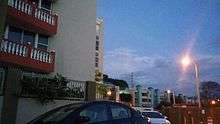
The city has had several natural disasters. It faced a major economic downturn due to the closure of its textile factories and tuna industry, which were the principal industries of the city for the greater part of the 20th century. Over 11,000 permanent jobs in these two industries were lost in the city during the 1990s, and because of this, Mayagüez became the jurisdiction of the United States with the second most industrial job losses during the time, second only to Flint, Michigan. Once the third city in population and importance in Puerto Rico, population numbers for it have been relatively stagnant, and it has lost population.
Mayagüez has a floating population due to its universities, principally the University of Puerto Rico- Mayagüez Campus of about 15,000-20,000 which contributes considerably to its economy.
In 2005 Winston-Salem Industries for The Blind was the first industry to move into the city's industrial park in many years. In July 2007 Honeywell opened a customer support service center for its aerospace and information technology divisions in the city.
Culture
Contributions to Puerto Rican gastronomy
Mayagüez's contributions to Puerto Rican gastronomy have been many, and a few of these are known outside Puerto Rico. Besides being host to one of the largest concentrations of mango trees in the island, the city has been a host to various food enterprises whose products are popular in Puerto Rico (and some elsewhere):
- Brazo gitano - literally "gypsy arm", is the locally produced Swiss or jelly roll, originally from Spain. E. Franco & Co., a bakery, food importer, and restaurant established in the late 1850s, is the best-known provider of brazos gitanos in town. Another (more recent) provider is Ricomini Bakery, whose central store in downtown Mayagüez has been open for over 100 years.
- Sangría de Fido - the heirs of Wilfrido Aponte still bottle "Sangría de Fido", a powerful concoction inspired by sangria, but made with fruit juices, Bacardi 151 rum and burgundy wine (technically not from Bourgogne, but produced by E & J Gallo Winery in Modesto, California). It had been bottled by hand by the bartender since the mid-1970s. "Sangría de Fido" has a sizeable reputation outside Puerto Rico, and can claim tasters from as far away as California and Spain. E & J Gallo once awarded Aponte with a "Customer of the Year" award and flew him to their headquarters. Aponte was reportedly offered $250,000 by Bacardi to sell his original recipe once, to which he refused.
- Bolo's Sorullitos - a now-defunct operation that originated at Bolo's Restaurant, a seaside eatery next to Mayagüez Bay, which produced sorullitos, or fried cornsticks, along with mayo-ketchup, a dip made of mayonnaise, ketchup, and garlic extract. The restaurant was popular in Puerto Rico between the late 1970s and mid-1980s (its custom-made building now houses WORA-TV, one of the local television stations). For a while the frozen cornsticks were sold commercially in stores.
- Flan-Es-Cedó' - Elmec Industries, Inc. has been the local flan producer for over thirty years
- India / Medalla beer - the only remaining mass-produced Puerto Rican beer is brewed by "Cervecería India", one of the largest employers in town. Mayagüezanos are queued into morning rush hour, lunch and afternoon rush hour by the company's whistle, which rings at 7:00 am, 8:00 am, 12:00 pm, 1:00 p.m. and 5:00 p.m. (all times AST)
- Rex Cream's Ice Cream - established in the mid-1960s by Chinese migrants who came to Puerto Rico by the way of Costa Rica, Rex Cream is a chain of ice cream parlors that had its heyday in the late 1970s. The two flagship stores in Mayagüez, however, are still popular (particularly on Good Friday, since one of the stores is the endpoint for a Good Friday religious procession) for producing alternative ice cream flavors, particularly a corn sherbet.
- Tuna fish - At one time, StarKist, Chicken of the Sea, and Bumble Bee produced 80% of their collective production for consumption in the United States in Mayagüez. The last remaining tuna fish cannery closed in 2012 when Bumble Bee shuttered their operation.[33]
- A new distillery was founded in Mayagüez in 2009, Destilería Coquí. Its production is limited to 100 bottles a day, their main product is artisan rum called Pitorro.[34]
A defunct cola bottling operation in town produced "Vita Cola", a popular soft drink in Puerto Rico between the late 1940s and early 1960s.
Mayagüez was a major rum producing city in Puerto Rico between the 1930s and 1970s . Several brands were produced by the city's three rum distillers. The most successful rum producing operation at the time was José González Clemente y Co., the bottlers of Ron Superior Puerto Rico, an award-winning dark rum that was bottled between 1909 and the late-1970s.
Festivals and events
Mayagüez celebrates its patron saint festival in late January / early February. The Fiestas Patronales Virgen de la Candelaria is a religious and cultural celebration that generally features parades, games, artisans, amusement rides, regional food, and live entertainment.[10][35]
Other festivals and events celebrated in Mayagüez include:
- Three Kings Day Festival – January
- Romance on the Boulevard – February
- Bomba and plena festival – February/March
- Mothers Day concert – May
- Fathers Day concert – June
- Mayagüez Carnival – May
- Danza Festival – May
- Celebration of the founding of Mayagüez – September
- Crafts fair – November
- Christmas festivities – December
- Anniversary of the Puerto Rican flag – December
- Band concert at the Patriots Park – second Sunday of the month
- Pedestrian Mayagüez at Columbus Square – third Sunday of the month
Sports

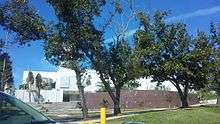
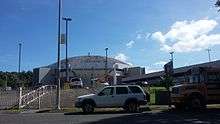
Mayagüez hosted the 2010 Central American and Caribbean Games for which the local and commonwealth governments have provided an investment of $250 million[36] for, among other things, building two new stadiums (the first a re-built Isidoro García Baseball Stadium the second next to it a track and field and soccer stadium.[37] Mayagüez also hosted the 2011 Caribbean Series.[38]
Mayagüez's National Superior Basketball League (BSN) professional basketball team, the Indios de Mayagüez, are named in honor of the city's Indian heritage. Its baseball winter league team (LBPPR), the Indios de Mayagüez, honor their Indian heritage and the home town's Cervecería India brewery. The professional soccer club Puerto Rico Sol, plays locally at local Mayagüez Athletics Stadium. The professional volleyball team Indias de Mayagüez from Liga de Voleibol Superior Femenino, plays locally at local Palacio de Recreación y Deportes.
The "Justas" or Inter University Games of the Liga Atlética Interuniversitaria de Puerto Rico, were held in Mayagüez in 2010 in preparation for the Central American and Caribbean Games.[39] Also they were held in 2016 and they are to be held in 2017.
Tourism
There are 13 beaches in Mayagüez.[40]
Landmarks and places of interest
- Centro Cultural Baudilio Vega Berríos (Municipal Cultural Center)
- Casa Consistorial De Mayaguez
- Casa Grande Museum
- Gomez Residence
- India Brewery
- Plaza Colón
- Customs House
- Dr. Juan A. Rivero Zoo
- Parque del Litoral Israel "Shorty" Castro
- Eugenio María de Hostos Monument
- Hostos Museum at Río Cañas Arriba Ward
- José de Diego Park
- Mayagüez Children's Library[41]
- Mayagüez Mall
- Mayagüez Resort & Casino
- Muelle Francés (French Dock)
- Parque de los Próceres (Notable's Park)
- Parque Infantil del Milenio (Millennium Child Park)
- Public Library (at Municipal Cultural Center)
- Tropical Agricultural Research Station
- Teatro Yagüez (Yaguez Theater)
- University of Puerto Rico at Mayagüez (El Colegio)
- Urayoán Monument
- RUM Planetarium
- RUM General Library
Gallery
 Mayaguez City Hall with its Christmas decoration. Register of Historic Places.
Mayaguez City Hall with its Christmas decoration. Register of Historic Places. Yaguez Theater which is in the National Register of Historic Places
Yaguez Theater which is in the National Register of Historic Places Customs House in Marina sector. Register of Historic Places
Customs House in Marina sector. Register of Historic Places Museum House of Pilar Defilló (mother of Pablo Casals)
Museum House of Pilar Defilló (mother of Pablo Casals).jpg) Entrance to the House Museum of Pilar Defilló
Entrance to the House Museum of Pilar Defilló Casa Grande museum at Mendez Vigo Street
Casa Grande museum at Mendez Vigo Street Parque del Litoral
Parque del Litoral Plaza Colón with City Hall on background, Christmas 2006
Plaza Colón with City Hall on background, Christmas 2006 Nuestra Señora de la Candelaria Cathedral, Christmas 2006
Nuestra Señora de la Candelaria Cathedral, Christmas 2006 University of Puerto Rico, Mayaguez – Portico
University of Puerto Rico, Mayaguez – Portico
Government

As one of Puerto Rico's 78 municipalities, Mayagüez's government has two branches, the executive and the legislative. Those citizens eligible to vote, directly elect a mayor and the municipal assembly for four-year terms. The municipal government is housed in Mayagüez City Hall or Casa Alcaldia, which faces the south-side of the Plaza de Colon.
The executive branch is headed by a popularly elected mayor. The office is held by El Cacique José Guillermo Rodríguez. In addition to running the city's day-to-day operations and supervising associated departments, the mayor is also responsible for appointing a secretary-auditor and a treasurer.
Mayagüez's Municipal Assembly is made up of sixteen elected officials, as defined in the Puerto Rico Law of Autonomous Municipalities of 1991.
The city belongs to the Puerto Rico Senatorial district IV, which is represented by two Senators. In 2012, María Teresa González and Gilberto Rodríguez were elected as District Senators.[42]
Public services
Fire and safety
Law enforcement in Mayagüez is the joint responsibility of the Mayagüez Municipal Police Department and the Puerto Rico Police Department. The first fire fighters corps in the city was created in 1876.[43]
Symbols
Flag
The wide cross represents Christianity brought to the New World by Christopher Columbus,[44] who signed his documents with the phrase and the motto Christ Ferens, which means: "He who has Christ." The blue and white waves between the third and fourth quarters recall the coat of arms granted to Columbus by kings Ferdinand and Isabella. The waves represent the ocean (and particularly Mona Passage) through which he sailed to bring the gospel to these new lands. The blue and white waves symbolize the Yagüez River and evokes the nickname City of Pure Waters. The red and white flames on the flag symbolize the traditional bonfires of Day of Our Lady of Candelaria ("Día de La Candelaria"), ignited in honor of the city's patron saint(a tradition started for Spanish settlers from the Canary Islands).[44] The flag was officially adopted with the signing of City Ordinance 38, signed December 3, 1996.[44]
Coat of arms
According to the Puerto Rican historian Federico Cedó Alzamora, the original version of the coat of arms of Mayagüez was given to the city 19 December 1894 by the Queen Regent of Spain Maria Christina of Austria.[43] The upper half of the coat of arms shows the columbine coat of arms recalls and commemorates the discovery of the Island of Borinquén (Puerto Rico) by Columbus in his second trip to the New World in 1493. The lower half of the coat of arms shows a stylized dissembarkment of Columbus on Puerto Rico. The explorer's crew disembarked at the western coast of the island,[43] where several rivers spill their waters in the Mona Passage, among them the Yagüez, from which the name of Mayagüez is derived. The present version was reinterpreted by heraldist Roberto Biascochea Lota.
Anthem
The city's anthem was written by pianist and former music teacher Luciano Quiñones,[45] a long-time resident and now "adopted son" of the city. Until this song's adoption, the plena "A Mayagüez", written by César Concepción, was used by many as an unofficial city song. Quiñones' composition was the winner of a contest sponsored by the city's municipality in 2003.[46]
Mayor José Guillermo Rodríguez and the Municipal Legislature entrusted the Advisory Board of Art and Culture of Mayagüez to hold a contest to select an anthem for the city.[46] The selected composition was a danza by Mr Luciano Quiñones, who has a bachelor's degree in music, a piano professor the Escuela Libre de Música de Mayagüez, he is a music composer already winning nineteen awards in competitions held by the Institute of Puerto Rican culture, and the Circulo de Recreo de San Germán.[46] The lyrics alludes to the emblematic symbols of Mayagüez; its nicknames, to its Patron Saint, its taste of mango, to its sunsets in the bay, to the Taíno, to Eugenio María de Hostos, their role as cultural cradle, the sympathy of the ladies and the dream of its valleys and its mountains.[46]
The anthem was presented to the people in a memorable concert held in commemoration of the 239 anniversary of the founding of the city on the night of September 18, 1999, interpreted by tenor, Mayagüez adopted son, Rafael José Díaz, Mayagüezana lyric soprano, Hilda Ramos, accompanied by the Puerto Rico Symphony Orchestra conducted by its Associate Director, Mayagüezana Roselyn Pabón, in the same place where such Symphony Orchestra offered his first concert forty years earlier: the Plaza Colón.[46] This danza was recognized as the official anthem of Mayagüez through the Municipal Ordinance number 58, series 1999-2000, adopted on 20 December 1999 by the City Council, which was signed by the Mayor, Honorable José Guillermo Rodríguez on December 24, 1999.[46]
MIDI and recorded versions of the anthem can be listened to here.[47]
Education
Public schools
The Residential Center for Educative Opportunities of Mayagüez, (CROEM) is one of only two public boarding schools in Puerto Rico. The largest public high school in town is Eugenio María de Hostos High School. The other public high school in Mayaguez is Dr. Pedro Perea Fajardo Vocational High School. The former José De Diego High School was finally closed in 2009.
Private schools
The non-profit Southwestern Educational Society (SESO) maintains the Southwestern Community School, an English language college preparatory school. Other private schools include: Colegio San Benito, (CSB) (Saint Benedict College), the Academia de la Inmaculada Concepción (Academy of the Immaculate Conception), Colegio Episcopal San Andrés (San Andres Episcopal College), Colegio Presbiteriano Pablo Casasús (Has been closed since 2016), Colegio De La Milagrosa (College of Our Lady of Miracles), the Academia Adventista del Oeste (Western Adventist Academy) and Academia Adventista de Bella Vista (Bella Vista Adventist Academy).
Colleges and universities
Mayagüez has become a major college town, due in part to various higher learning institutions in the city.
- University of Puerto Rico at Mayagüez
- Eugenio María de Hostos School of Law
- Pontifical Catholic University of Puerto Rico at Mayagüez
- Antillean Adventist University
- Carlos Albizu University
There are also a number of junior colleges in the city:
- Instituto Comercial de Puerto Rico Junior College
- Instituto de Banca y Comercio
- Ponce Paramedical College
- Escuela Hotelera de San Juan - Recinto de Mayagüez
- John Dewey College
Health care & hospitals
- Mayaguez Medical Center
- Hospital Perea
- Hospital San Antonio
- Hospital Bella Vista
- Clinica Yaguez
- Policlinica Bella Vista
Transportation
_alturas%2C_Mayag%C3%BCez.jpg)
Roads and highways
The dominant form of transport in Puerto Rico is the automobile. Mayagüez is served by two highways linking it to other parts of the island.
Puerto Rico Highway 2 existing as an arterial road is a primary route between Ponce to the south-east and Aguadilla and Arecibo to the north and north-east respectively. PR-2 is undergoing a conversion to a freeway between Ponce and Mayagüez.
Another important route in Mayagüez is PR-102. It begins at an intersection with PR-2, about 2 miles north of Mayagüez Pueblo at the Mar y Sol development and runs along Mayagüez's coastal industrial areas to Joyuda, where it then turns east and terminates in Sabana Grande.
The portion of the highway adjacent to the Estadio Isidoro Garcia was upgraded from a two-lane road into an urban boulevard in anticipation of the 2010 Centro-American and Caribbean Games celebrated in Mayagüez. In addition to this upgrade, an elevated by-pass was constructed from the coastal park site over the Yagüez River ending at the Concordia Housing Project.
There are 41 bridges in Mayagüez.[48]
Public transportation

Transportation in Mayagüez is limited to a trolley service, various private taxi companies and an occasional daytime syndicated público service named Mayagüez Urbano (Urban Mayagüez) that provide transportation between the main points of the city at a cost of $2.00 per route. Passenger transportation between Mayagüez and San Juan is operated by the Linea Sultana, another syndicated service.[49]
The city operates three trolleys, free of charge, which run as shuttles between the downtown area and the Palacio de Recreación y Deportes.[50]
The University of Puerto Rico at Mayagüez (UPRM) also runs an internal network of trolleys to carry its students inside campus and between UPRM's Mayagüez Terrace development and Palacio de Recreación y Deportes,[51] linking here with the city's trolley service. There are some proposals to expand the municipal trolley service to serve inside the UPRM.[52]
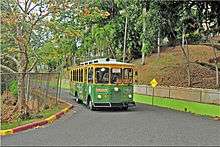
For the 2010 Central American and Caribbean Games the Puerto Rico's Department of Transportation and Public Works released an express public bus system operated with Autoridad Metropolitana de Autobuses (San Juan's Metropolitan Bus Authority) buses specially assigned to serve the city of Mayagüez. During the Mayagüez 2010 Games, this bus network was carrying passengers in a corridor along Highway 2 and some main roads. The UPRM trolleybus network was integrated into this service too. Although suspended after the Mayagüez 2010 Games ended, the system is expected to be re-established shortly.[53]
Seaport

The Port of Mayagüez is the third busiest port on Puerto Rico.[54] It was base for several years to several tuna and fish companies who made the port a considerable busy one. It was normal to see 3 to 4 ships docked at any given day but due to the Section 936 termination the industries started to leave until 2000 approximately when only the ferry and the Federacion de Industria Agropecuaria silos pier were left. It is located northwest of the central business district along Puerto Rico routes 64, 341, and 3341, and stretches for 3.8 miles (6.1 km) along the coast. Its main canal is 0.4 miles (0.64 km) wide and its depth ranges from 47 to 120 feet (14 to 37 m), the water's depth along the piers ranges between 28 and 29 feet (8.5 and 8.8 m). The port is protected from rough seas by reefs which run along its northern and western sections.[55]
On March 16, 2011 a new ferry service to Dominican Republic was launched by America Cruise Ferries.[56] Late 2016 the municipal administration awarded an administration contract to a private company after years of legal disputes and non complying groups involved. The municipal administration had plans of development for the port back to 2004 when they received a portion of port area from the central government( the ferry pier and terminal) but 12 years later the port has seen very little to none progress.
Airport
Mayagüez's airport, Eugenio María de Hostos Airport, also known as El Mani Airport, has had regular airline services for more than thirty years.[57] It is located 4 miles north of the central business district in the Sabanetas Barrio. Before being inaugurated in 1955, the airport served as a military base. In the 1970s it had domestic service from Prinair, then from American Eagle and Eastern Air Lines's regional carrier Eastern Metro Express in the 1980s. After Eastern went bankrupt in 1991, American Eagle remained the only airline serving the airport until it ended service to the city on April 30, 2005, due to poor loads.[58] For a while, Fina Air served flights to the Dominican Republic before the airline went bankrupt. Cape Air currently serves the airport with 5 daily flights to San Juan during the high season and three daily flights during the low season.[59]
Notable people
- Eugenio María de Hostos
- Frankie Ruiz
- María Luisa Arcelay
- Carlos Vargas Ferrer
- Maria Arrillaga
- Baudilio Vega Berríos
- Olga A. Méndez
- Alicia Moreda
- Martín Travieso
- Madeline Willemsen
- Gina Lynn
- Hernán Padilla
- Roberto Roena
- Noemí Ruiz
- José Juan Barea
- Roberto Sanchez Vilella
- Lucy Boscana
- José E. Serrano
- Keylla Hernandéz
- Kobbo Santarrosa
International relations
Mayagüez serves as a host city for two foreign consulates with business in Puerto Rico:


Sister cities


Books
- Gaudier, Martín, Genealogías, Biografías e Historia del Mayagüez de Ayer y Hoy y Antología de Puerto Rico, 1957.
See also
| Wikimedia Commons has media related to Mayagüez, Puerto Rico. |
- Timeline of Mayagüez, Puerto Rico
- Territories of the United States
- List of Puerto Ricans
- History of Puerto Rico
- National Register of Historic Places listings in Mayagüez, Puerto Rico
- Did you know-Puerto Rico?
References
-
"Mayagüez – Populated Place". Geographic Names Information System. USGS. Retrieved May 14, 2008.

- "Puerto Rico – Municipio". U.S. Census Bureau. Archived from the original on February 12, 2020. Retrieved March 24, 2006.

- Aguilo Ramos, Silvia (1984). Mayaguez: Notas para su Historia. San Juan, Puerto Rico: Model Offset Printing. p. 46.
- Loida Figueroa, "Escudo de Mayagüez" Anuario de las Fiestas Patronales, 1977
- Joseph Prentiss Sanger; Henry Gannett; Walter Francis Willcox (1900). Informe sobre el censo de Puerto Rico, 1899, United States. War Dept. Porto Rico Census Office (in Spanish). Imprenta del gobierno. p. 164.
- "Earthquake of 1918". Puerto Rico Seismic Network. University of Puerto Rico - Mayaguez. Archived from the original on February 10, 2005. Retrieved February 2, 2005.
- "Preliminary Locations of Landslide Impacts from Hurricane Maria, Puerto Rico". USGS Landslide Hazards Program. USGS. Archived from the original on March 3, 2019. Retrieved March 3, 2019.
- "Preliminary Locations of Landslide Impacts from Hurricane Maria, Puerto Rico" (PDF). USGS Landslide Hazards Program. USGS. Archived (PDF) from the original on March 3, 2019. Retrieved March 3, 2019.
- Bureau, U.S. Census. "American FactFinder - Results". factfinder.census.gov. Archived from the original on February 14, 2020. Retrieved March 20, 2018.
- "Mayaguez Municipality". enciclopediapr.org. Fundación Puertorriqueña de las Humanidades (FPH). Archived from the original on June 21, 2019. Retrieved March 20, 2019.
- "Average Weather for Mayaguez, PR - Temperature and Precipitation". Weather.com. Archived from the original on August 7, 2013. Retrieved June 7, 2012.
- Picó, Rafael; Buitrago de Santiago, Zayda; Berrios, Hector H. Nueva geografía de Puerto Rico: física, económica, y social, por Rafael Picó. Con la colaboración de Zayda Buitrago de Santiago y Héctor H. Berrios. San Juan Editorial Universitaria, Universidad de Puerto Rico,1969. Archived from the original on December 26, 2018. Retrieved December 31, 2018.
- Gwillim Law (May 20, 2015). Administrative Subdivisions of Countries: A Comprehensive World Reference, 1900 through 1998. McFarland. p. 300. ISBN 978-1-4766-0447-3. Retrieved December 25, 2018.
- Puerto Rico:2010:population and housing unit counts.pdf (PDF). U.S. Dept. of Commerce, Economics and Statistics Administration, U.S. Census Bureau. 2010. Archived (PDF) from the original on February 20, 2017. Retrieved December 31, 2018.
- "Map of Mayagüez at the Wayback Machine" (PDF). Archived from the original (PDF) on March 24, 2018. Retrieved December 29, 2018.
- "Archived copy". Archived from the original on December 18, 2019. Retrieved December 18, 2019.CS1 maint: archived copy as title (link)
- "US Census Barrio-Pueblo definition". factfinder.com. US Census. Archived from the original on May 13, 2017. Retrieved January 5, 2019.
- "Agencia: Oficina del Coordinador General para el Financiamiento Socioeconómico y la Autogestión (Proposed 2016 Budget)". Puerto Rico Budgets (in Spanish). Retrieved June 28, 2019.
- Rivera Quintero, Marcia (2014), El vuelo de la esperanza: Proyecto de las Comunidades Especiales Puerto Rico, 1997-2004 (first ed.), San Juan, Puerto Rico Fundación Sila M. Calderón, ISBN 978-0-9820806-1-0
- "Leyes del 2001". Lex Juris Puerto Rico (in Spanish). Retrieved June 24, 2020.
- Rivera Quintero, Marcia (2014), El vuelo de la esperanza:Proyecto de las Comunidades Especiales Puerto Rico, 1997-2004 (1st ed.), San Juan, Puerto Rico Fundación Sila M. Calderón, p. 273, ISBN 978-0-9820806-1-0
- "Comunidades Especiales de Puerto Rico" (in Spanish). August 8, 2011. Archived from the original on June 24, 2019. Retrieved June 24, 2019.
- "Historia de Mayagüez 1760-1960"; by Subcomite de la Historia de Mayaüez (Author); Page: 61; Publisher: Talleres Graficos Interamericanos (1960); Language: Spanish
- Eugenio Fernández Méndez,"Noticias de la Historia Geográfica, Civil y Politica de Puerto Rico, por Fray Iñigo Abad y Lasierra", 1782
- Eugenio Fernández Méndez, "Relación del Viaje a la Isla de Puerto Rico del Naturista Pierre Ledrú, 1797", Crónicas de Puerto Rico (España, 1969) p.337
- "Genealogias Biografias e Historia del Mayagüez de Ayer y Hoy y Antologia de Puerto Rico"; by Martin Gaudier (Author); Page: 47; Publisher: Imprenta "El Aguila", San German (1959); Language: Spanish
- Documentos Históricos de Mayagüez, 1836, Vol. 3.
- "Historia de Mayagüez 1760-1960"; by Subcomite de la Historia de Mayaüez (Author); Page: 68; Publisher: Talleres Graficos Interamericanos (1960); Language: Spanish
- "Census PR" (in Spanish). Archived from the original on October 7, 2009. Retrieved August 10, 2009.
- "American Factfinder: Persons per Square Mile". United States Government. Archived from the original on October 21, 2012. Retrieved June 10, 2011.
- "Mayagüez Municipio, Puerto Rico". United States Government. Archived from the original on September 30, 2017. Retrieved June 10, 2011.
- "Ethnicity 2010 census". Factfinder2.census.gov. October 5, 2010. Archived from the original on February 12, 2020. Retrieved June 7, 2012.
- Kantrow, Michelle (May 1, 2012). "Bumble Bee closing Mayagüez plant after 50 years, leaving 260 jobless". Archived from the original on June 8, 2018. Retrieved May 26, 2018.
- Archived August 27, 2009, at the Wayback Machine
- J.D. (May 2, 2006). "Mayagüez". Link To Puerto Rico.com (in Spanish). Retrieved July 18, 2020.
- Recreación & Deportes, archived from the original on July 24, 2010, retrieved July 21, 2010
- Archived November 21, 2009, at the Wayback Machine
- Confirmada la sede del 2011 Archived September 29, 2011, at the Wayback Machine
- "Primerahora.com". Primerahora.com. Archived from the original on August 9, 2013. Retrieved June 7, 2012.
- "Las 1,200 playas de Puerto Rico [The 1200 beaches of Puerto Rico]". Primera Hora (in Spanish). April 14, 2017. Archived from the original on December 12, 2019. Retrieved December 12, 2019.
- "bibliotecajuvenil.org". Archived from the original on May 6, 2016. Retrieved January 5, 2020.
- Elecciones Generales 2012: Escrutinio General Archived 2013-01-15 at the Wayback Machine on CEEPUR
- "Historia de Mayagüez 1760-1960"; by Subcomite de la Historia de Mayaüez (Author); Page: 92; Publisher: Talleres Graficos Interamericanos (1960); Language: Spanish
- "Mayaguez-municipio de Puerto Rico-datos y fotos". Prfrogui.com. Archived from the original on March 9, 2010. Retrieved June 7, 2012.
- "Mayaguez". Salonhogar.com. Archived from the original on April 15, 2009. Retrieved June 7, 2012.
- Cedó Alzamora, Federico, El Himno de Mayagüez, Publicación Oficial #010 (in Spanish), Oficina del Historiador de Mayagüez., archived from the original on August 10, 2011, retrieved July 21, 2010
- "Himno a Mayagüez". Ladanza.com. Archived from the original on October 13, 2007. Retrieved June 7, 2012.
- "Mayagüez Bridges". National Bridge Inventory Data. US Dept. of Transportation. Archived from the original on February 22, 2019. Retrieved February 20, 2019.
- "Línea Sultana". Archived from the original on July 14, 2011. Retrieved March 1, 2011.
- "Trolly/Transportacion/Mayagüez". Archived from the original on May 21, 2007. Retrieved July 31, 2007.
- "Rutas del Trolley". Archived from the original on May 22, 2011. Retrieved March 1, 2011.
- "Confirman vínculos de colaboración". Archived from the original on December 21, 2010. Retrieved March 1, 2011.
- "Transportation secretary to lend a hand at games". Puerto Rico Daily Sun. Retrieved July 17, 2010.
- Puerto de Mayagüez, Puerto Rico, Mayagüez, Puerto Rico, July 31, 2007
- Casiano Communications (January 20, 2011). "DR ferry from Mayagüez, SJ to launch in March". Caribbeanbusinesspr.com. Archived from the original on March 10, 2012. Retrieved June 7, 2012.
- "American Eagle To End Service To Mayagüez Civil Aviation Forum". Airliners.net. Archived from the original on June 29, 2011. Retrieved June 7, 2012.
- Archived July 26, 2011, at the Wayback Machine
- "Travel Documents Dominican Republic" (in Spanish). Archived from the original on April 18, 2009. Retrieved May 1, 2008.
- "gopuertorico.org" (in Spanish). Archived from the original on February 18, 2009. Retrieved May 1, 2008.
External links
| Wikivoyage has a travel guide for Mayagüez. |
- Mayaguez, Puerto Rico
- Mayaguez 2010 Central American and Caribbean Games


- Current weather in Mayagüez from: Weather Underground
- Peter van der Krogt's page about the Columbus monument at Mayagüez's Plaza de Colón

- Puerto Rico Government Directory - Mayaquez